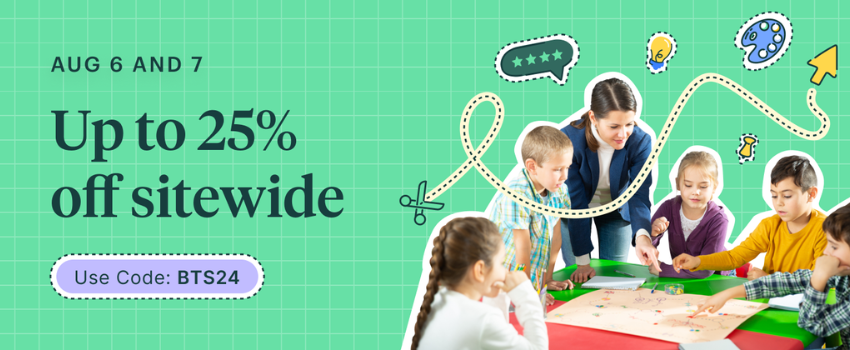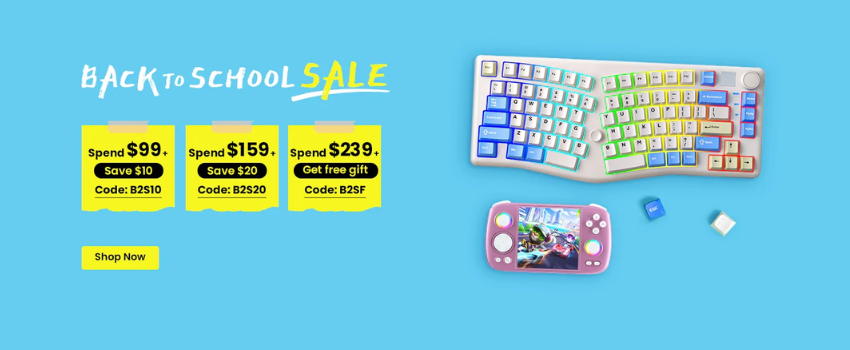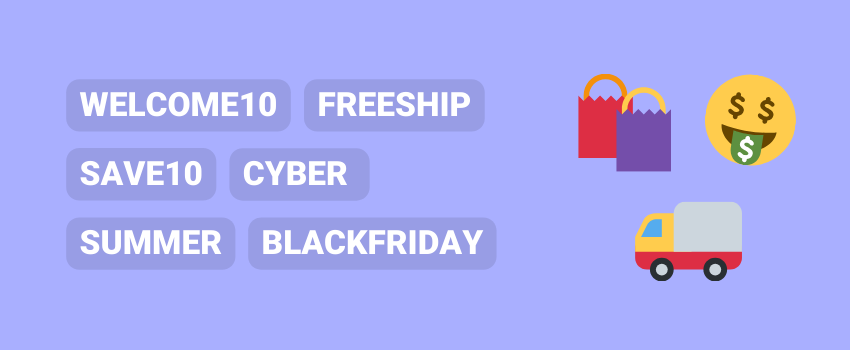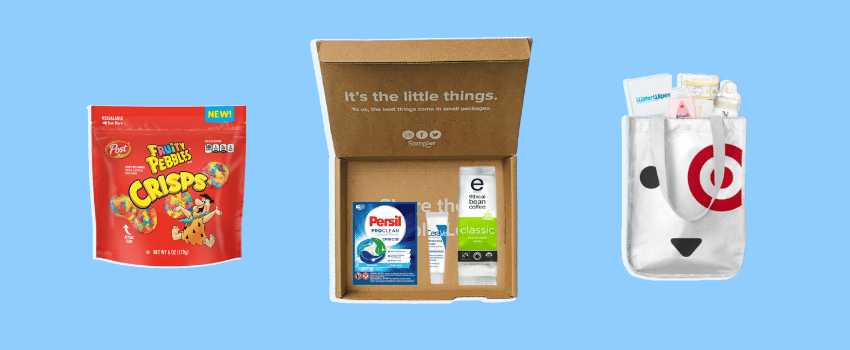No votes yet.

How to Create a Coupon Marketing Strategy
Updated 23 min read
One of the best strategies to attract and retain customers is via coupons. Our coupon marketing strategy guide will walk you through everything you need to know about creating, distributing, and managing a successful coupon advertising campaign. The guide covers basic and advanced tactics, with actionable insights about how coupon marketing creates brand loyalty.
What Is Coupon Marketing?
Coupon marketing uses discounts and special offers to attract new customers and retain existing ones. It boosts sales, improves customer loyalty, and builds brand recognition. How? It’s simple, actually. Deals with immediate value help businesses create a sense of urgency and drive online and in-store traffic.
The coupons can be distributed through many channels, including email, social media, and physical flyers, making them a versatile tool for reaching a broad audience.
💡
Tip: Coupon marketing should be included in a broader marketing strategy for clearing excess inventory, launching new products, or increasing brand visibility.
Should You Have a Coupon Marketing Strategy?
The short answer is: yes, investing in coupon marketing is worth it. A coupon advertising strategy delivers great returns on investment as long as you implement it properly.
Coupons help customers save money instantly without any effort. On average, customers save $376 yearly on electronics & gadgets and $357 yearly on clothing and accessories using coupons. Offering coupons makes your brand a more appealing choice, increasing overall sales volume and revenue. Even if you sell at a lower price per unit because of the discount, the increase in the amount sold offsets this.
8 Reasons to Have a Coupon Marketing Strategy
Coupon marketing can drive sales, attract new customers, encourage loyalty, and help you manage inventory, all while meeting customer expectations and reducing cart abandonment.
- Boost sales faster: coupons drive sales by motivating customers to purchase now rather than later. According to our survey, 66% of customers have made impulse buys because a coupon was available.
- Grow your customer base: coupons attract new customers who might not have considered your brand otherwise. In fact, 62% of shoppers are more inclined to try a new product if they are getting a coupon or personalized offer.
- Improve customer loyalty: exclusive discount codes for repeat purchases build long-term relationships. This way, loyal customers are likelier to spend more and refer others to your brand.
- Beat the competition: offering more attractive discount codes than your competitors can help you keep more customers. Research shows that 71% of customers have switched to a competitor because they offered a more attractive discount code.
- Move excess inventory: coupons help move excess and aging inventory quickly through price reductions and deals. This creates space for new stock and lets your product offerings stay fresh.
- Engage and retain customers: coupons also re-engage inactive customers. Sending an attractive offer to a customer who hasn’t purchased in a while can bring them back.
- Reduce cart abandonment: coupon codes can convince customers to complete purchases. Our research shows that 5% of US shoppers always abandon their carts if they can’t find a discount, 10% do it “often”, and 33% “sometimes”.
- Track your success rate: coupon redemption is trackable, helping you measure the results of the campaign. You can simplify this further by using unique coupon codes for every user.
A Step-by-Step Guide to Creating an Effective Coupon Marketing Strategy
1. Set Clear Objectives
Step 1 of your coupon marketing strategy must be setting your goals and expectations. Not sure where to start? Here are a few common objectives that businesses aim to achieve with their coupon campaigns:
- Generate brand awareness: coupons can introduce your brand to a broader audience. Distribute them through multiple channels such as social media, email newsletters, coupon websites, and partnerships with other brands or influencers.
- Improve customer engagement: interactive coupon campaigns are a great way to engage customers with your brand. For example, you can create gamified coupon experiences, such as scratch-and-win promotions, spin-to-win promotions, or social media contests.
- Boost average order value: offers like “buy-one-get-one” (for free, at half cost, etc) can increase the average order size. Even if you’re making less revenue per item, the order size going up balances it out. For example, offer coupon codes for discounts on bundled products or provide a coupon for a free item when the customer spends over a certain amount.
- Gather customer data: use coupons to collect customer data for future marketing efforts. For example, you can require customers to sign up or fill out a short survey to receive their coupon. This way, you gather information like email addresses, purchase preferences, and demographic data for more targeted marketing.
- Increase website traffic: digital coupons help drive traffic to your online store. By promoting exclusive online-only discounts through digital channels such as social media ads, email campaigns, and influencer collaborations, you can effectively attract customers to visit your website.
- Improve customer experience: use customer data to send personalized coupon offers based on their past purchases and browsing behavior. Automated systems can help you send these offers at the right time, such as on a customer’s birthday or after they’ve abandoned their shopping cart.
2. Understand Your Target Audience
To create an effective coupon marketing strategy, it’s important to understand who your customers are and what they want. Here’s how:
- Conduct surveys: use tools like SurveyMonkey or Google Forms to ask your customers about their shopping habits, preferences, and needs. Questions can cover topics such as favorite products, frequency of purchases, and preferred price ranges. Offer a discount or a chance to win a gift card as a thank-you for their time.
- Analyze purchase data: use customer relationship management (CRM) software like Salesforce or HubSpot to analyze your customers’ buying behavior. Look at purchase history, average spending, and product preferences. This will help you identify trends such as most purchased items or peak shopping times.
- Engage on social media: use social media platforms like Instagram, Facebook, or TikTok to interact with your audience. Run activities like polls, Q&A sessions, and user-generated content contests to create engagement and gather marketable insights based on customer behavior and responses. Reward participants with exclusive coupons or discounts.
- Monitor website traffic: tools like Google Analytics show you how customers interact with your website. Track metrics such as page views, time spent on site, and most visited pages. You can also look at which channels generate the most web traffic (organic, paid ads, social media, email, etc). This information will help you understand which products or services attract the most interest.
- Personalize email marketing: use email marketing services like Mailchimp or Constant Contact to automate sending personalized emails. Start by segmenting your email list based on customer behavior and preferences. Send targeted messages that ask for their opinions and feedback on your products. As an incentive, offer unique discount codes to those who take the time to share their thoughts or update their profile information. Email marketing can also be used to update customers about ongoing promotions, relevant company news, special discounts only for newsletter subscribers, and more.
3. Choose the Right Type of Coupon
In case you are wondering what are the most preferred coupon types, our survey reveals the following preferences among customers:
- 67% of shoppers like percentage-off coupons
- 61% of shoppers like “buy one, get one” BOGO coupons
- 57% of shoppers like free shipping coupons
- 48% of shoppers like fixed amount-off coupons
Next, decide what type of coupons align best with your coupon marketing strategy and overall business goals:
Percentage Off Coupons
- Goal: Increase average order value.
- Benefits: Offering a fixed percentage off the total purchase, like 20% off, encourages customers to spend more. The higher the product price, the more attractive the discount becomes.
Fixed Amount Off Coupons
- Goal: Boost conversion rates.
- Benefits: Providing a fixed dollar amount off, such as $10 off a $50 purchase, makes the savings transparent and easy to understand. This clarity encourages customers to complete their purchase.
Free Shipping Coupons
- Goal: Reduce cart abandonment.
- Benefits: Offering free shipping on orders over a certain amount removes the delivery cost. Free shipping can be a decisive factor that encourages customers to complete their purchases.
BOGO Coupons
- Goal: Increase average order value.
- Benefits: BOGO deals, like “buy 3, get 1 free,” encourage customers to buy more items than they originally intended. This increases the total amount spent on each order, helping your business earn more money and clear out inventory faster.
Welcome or First Order Coupons
- Goal: Attract new customers.
- Benefits: Offering a discount on the first purchase makes it easier for new customers to try your products. This helps you attract new clients and build a loyal customer base.
Holiday or Seasonal Coupons
💡
Tip: Create a 12-month sales calendar for your upcoming deals and align them with important dates and events in your industry. For instance, if you’re in the clothing sector, consider planning promotions around major holidays and fashion events. Scheduling in advance lets customers have something new and exciting to look forward to.
- Goal: Drive sales during special events.
- Benefits: Providing extra discounts during major shopping events like Black Friday or Cyber Monday creates a sense of urgency and exclusivity. For example, “Get an extra 5% off with code BF5” encourages customers to make quick purchases, thereby increasing sales during these opportune times of the year.
Referral Coupons
- Goal: Grow your customer base.
- Benefits: Encourage customers to refer friends to your business by offering discounts to both the referrer and the referred. This strategy helps you attract more customers through trusted referrals.
Gift with Purchase Coupons
- Goal: Improve customer perceived value.
- Benefits: Offering a free gift with certain products or orders adds extra value to purchases. This makes them more attractive and encourages customers to buy more.
Birthday and Anniversary Coupons
- Goal: Build customer loyalty.
- Benefits: Providing unique promo codes for anniversary and birthday discounts makes customers feel special and appreciated. This personal touch helps build long-term loyalty and motivates customers to come back for future purchases.
Abandoned Cart Coupons
- Goal: Recover lost sales.
- Benefits: Sending a discount code to customers who leave items in their cart without completing the purchase can encourage them to return and finalize their purchase. This method helps recover potential lost sales.
Purchase History Coupons
- Goal: Encourage repeat purchases.
- Benefits: Offering discount codes for products related to a customer’s past purchases ensures that the offers are highly relevant and attractive. This way, customers are more likely to buy again when they receive discounts on products they have previously shown interest in.
Geo-Targeting Coupons
- Goal: Target specific market segments.
- Benefits: Geo-targeting coupons use real-time location data to deliver personalized discounts to customers based on their geographic location. This ensures offers are relevant, increasing the chance of immediate purchases and improving customer satisfaction.
4. Create Effective Coupon Codes
Once you’ve decided on the discount, select a free coupon code generator tool or your e-commerce platform’s built-in functionality to create the codes, if available.
Keep in mind that good coupon codes are short, memorable, and relevant to the promotion. Therefore, make the code easy to read and type, avoiding complex combinations that can frustrate customers.
Here are examples of good codes to use in a coupon marketing strategy:
- “WELCOME10”: offers 10% off for new customers.
- “SUMMERSALE25”: provides a 25% discount during the summer season.
- “FREESHIP”: offers free shipping on orders over a certain amount.
- “BUY2GET1FREE”: purchase two items and get one free.
- “FLASH50”: 50% off during a limited-time flash sale.
5. Create Compelling Offers
Whether they’re percentage discounts, a fixed amount off, or a buy-one-get-one-free deal, make your coupon advertising compelling enough to prompt action but not so generous that it hurts your profit margins.
💡
Tip: Use strong CTAs like “Shop Now” and “Grab It Before It’s Gone” to create a sense of urgency. You can also include headlines such as “Limited-Time Offer,” “Exclusive Discount,” etc.
6. Set Clear Terms and Conditions
Setting expiration dates and other coupon restrictions helps create urgency so that customers use them sooner rather than later. Another important aspect is mentioning all limitations tied to the coupon, if applicable (this will keep customers from having false expectations).
Here are a few common terms and conditions for coupons you should cover:
- Expiration date: the validity period, such as “valid for one month from the date of issue”
- Minimum purchase requirement: whether coupons can only be used with a minimum purchase, such as “$50 to use the coupon”
- Product or category restrictions: for example, coupons could only be applicable to non-sale items.
- One-time use or multiple uses: mention whether coupons can be used one time per customer or multiple uses
7. Design Eye Catching Coupons
The design of your coupon is as important as the offer itself. Make it visually appealing and easy to understand.
Include elements such as:
- A clear call-to-action (CTA): “use code SAVE20 at checkout”
- The discount details: “get 20% off your next purchase”
- Your brand logo: your logo must be easily visible to make your brand recognizable
- Terms and conditions: such as “valid only on purchases over $50”
- Expiration date: while validity dates don’t have to be front and center, you should still include information such as “expires: MM/DD/YYYY”
💡
Tip: Use Canva’s free online coupon maker tool to design custom coupons for your business, or hire a professional designer to align your coupons with your brand’s identity.
Here are some real examples:



8. Distribute Your Coupons Effectively
To make sure your coupons reach the right audience, it’s important to distribute them through the channels that shoppers use most frequently. Based on our survey, here are the most popular ways shoppers find coupon codes:
- 48% use search engines
- 44% visit coupon websites
- 43% use mobile apps
- 34% browse on social media
- 32% use coupon browser extensions
- 21% find on retailer newsletters
With this information in hand, let’s look at some tips and tricks for each distribution channel.
Search Engines
Considering that most shoppers find coupons using search engines, it’s important to create a dedicated coupon page on your website like Sephora’s Beauty Offers and Macy’s Deals, Coupons, and Promotions. This will help your website appear in search results when users look for “Brand Name coupon.”
Coupon Websites
Coupon platforms aggregate discounts and deals, creating a one-stop shop for saving money at dozens, hundreds, or even thousands of brands. Getting listed on high-authority coupon websites with a strong presence in Google Search (and Bing, Yahoo, Brave, DuckDuckGo, etc) brings you many benefits.
💡
Tip: Want to share your coupons on DontPayFull.com? Just send us a request at support@dontpayfull.com.
In-App Notifications
If you have a mobile app, use push notifications to send promo codes directly to users. Personalize the notifications based on user behavior within the app. For instance, if a user frequently browses a category but hasn’t made a purchase, send a discount code for that category.
💡
Tip: Monitor the effectiveness through app analytics to see how many users engage with the notification and redeem the code. Adjust your coupon marketing strategy accordingly.
Social Media
Share discount codes through posts, stories, and ads on platforms like Facebook, Instagram, and Twitter. Use hashtags to reach a broader audience, and create visually appealing graphics or videos to grab attention.
💡
Tip: Monitor the performance of your posts and ads using social media analytics tools to adjust your strategy as needed.
Coupon Browser Extensions
Distributing your coupons through browser extensions can increase their reach and usage. These extensions automatically apply the best available coupon codes during the checkout process, making it easier for users to save money and complete their purchases.
💡
Tip: By partnering with us, your brand will be featured on our DontPayFull Automatic Coupons Extension.
Email Campaigns
Send personalized offers to your email list – this builds a direct line of communication with your customers. Segment your email list based on customer behavior, purchase history, or demographic information to make the offers more relevant.
Legal note: this method must be in compliance with regulations, such as obtaining consent and providing opt-out options.
💡
Tip: If a group of customers frequently purchases a product, send them a coupon for a discount on that item. Use A/B testing to find the best subject lines and email content to improve open rates and conversion rates for your coupon advertising.
Website Pop-Ups
Capture attention by displaying coupons on your website. However, only use pop-ups where they don’t upset the user experience and the user journey. Otherwise, they will frustrate customers and affect your SEO negatively. Timed pop-ups might not be the most UX-friendly, as they are not tied to specific user actions.
💡
Tip: Create pop-ups that react to what the user does on the website so that they feel organic and natural in their journey. Use A/B tests for different designs and messages to see which ones have the highest conversion rates.
Influencer Partnerships
Collaborate with influencers who can share your discount codes with their followers, expanding the reach of your coupon marketing strategy. Choose influencers whose audience aligns with your product; otherwise, you won’t see great results. You can also negotiate the terms of the partnership, such as the type of content the influencers will create and the frequency of posts.
💡
Tip: Generate unique promo codes for affiliate marketers and track their performance through an affiliate marketing platform using UTM parameters to measure ROI.
Printed Material
Traditional methods like adding coupons in newspapers or flyers can still be effective for local businesses. You can also hand them out in-store. Design eye-catching printed materials and distribute them in high-traffic areas or through direct mail.
💡
Tip: Depending on your strategy, the printed materials might be coupons themselves and only usable in-store or have a digital code that’s usable online. Analyze the effectiveness via unique coupon codes that can be tracked when redeemed, so you can see what works best.
SMS Marketing
Send promo codes directly to customers via text messages. This coupon advertising channel can be highly effective due to higher open and read rates. In fact, over 95% of SMS messages are opened and read within the first 3 minutes, compared to email open rates of around 20-30%.
Legal note: this method must be in compliance with regulations, such as obtaining consent and providing opt-out options.
💡
Tip: Keep SMS messages under 160 characters and include a clear call to action. Plus, use SMS marketing platforms with analytics to track delivery rates, open rates, and redemptions.
Customer Receipts
Include a coupon code on printed or emailed receipts to encourage repeat purchases. This method works great because it targets customers who are already interested in your products. Make sure the receipts clearly show the coupon code and any terms or conditions.
💡
Tip: To track the success of this method, use unique codes on receipts. By using tools like Shopify POS, you can generate and track these codes automatically, making it easy to analyze your results.
Event Handouts
Distribute physical coupons or promo cards at industry events, trade shows, or local gatherings. Design attractive flyers that have the discount front and center and encourage attendees to visit your booth or website.
💡
Tip: Collect contact information in exchange for the coupons to build your customer database. Follow up with attendees after the event to remind them to use the promo codes.
9. Track and Analyze Performance
Monitor the performance of your coupon campaigns using analytics tools. Track key metrics such as redemption rates, total sales, average order value, and new customer acquisition. Analyzing this data will help you understand what works and what doesn’t.
- Use analytics tools: tools like Google Analytics, Adobe Analytics, or specialized coupon management platforms such as Voucherify or Yotpo can give detailed insights into your campaign performance. These tools can track various metrics, including redemption rates, total sales generated, average order value, and new customer acquisition.
- Set up tracking parameters: use UTM parameters in your coupon links to track the source of redemptions. This will help you identify which distribution channels are performing best. You can use utm.io, HubSpot, or other platforms to create UTM links.
- Monitor key metrics: key performance indicators (KPIs) such as redemption rates, total sales, average order value, and new customer acquisition will help you determine if your coupon advertising is successful.
- Create dashboards: use tools like Google Looker Studio or Tableau to create interactive dashboards that display your KPIs in real-time. This makes it easier to visualize and understand your data.
10. Adjust and Optimize
Based on campaign performance data, make adjustments to optimize your coupon strategy. If certain offers or distribution channels are underperforming, test different approaches or refine your tactics. Optimizing your strategy will ensure long-term success and maximize the ROI of your coupon marketing efforts.
- Identify underperforming areas: use your analytics data to pinpoint areas that are not meeting expectations. This could be specific coupons, distribution channels, or target segments.
- A/B testing: conduct A/B tests to compare different versions of your coupons and distribution methods. For example, you can test two different offers or two different email subject lines to see which one performs better. Use tools like Optimizely or VWO to run these tests.
- Adjust your offers: if some offers aren’t resonating with your audience, consider changing the offer type or value. For example, if a percentage discount is underperforming, try offering a fixed amount off or a buy-one-get-one-free deal.
- Refine targeting: use the insights from your data to refine your audience targeting. If certain segments are more responsive than others, allocate more resources to those segments.
- Update distribution channels: if some distribution channels are not performing as well as others, reallocate your efforts to the more effective channels. For example, if social media is generating more redemptions than email, focus more on social media campaigns.
- Automate where possible: use automation tools like Zapier or HubSpot to streamline your coupon distribution and tracking processes.
- Gather customer feedback: collect feedback from customers who have used your coupons. This can provide insights into how you can improve future offers.
- Iterate and improve: iterate on your strategies based on the data and feedback you gather. Coupon marketing is not a one-time effort but requires ongoing optimization to remain effective.
Online Coupon Marketing Strategy Challenges
Attracting the Wrong Customers
- Challenge: attracting the wrong customers via coupon advertising happens when too many discounts attract bargain hunters who may not become loyal customers. This means they might buy from you just during deep sales, affecting your bottom line.
- Solution: create coupons that are attractive but not overly generous to prevent attracting just deal-seekers. Use loyalty programs and personalized offers to reward repeat customers.
Managing Coupon Redemption Rates
- Challenge: Managing redemption rates is important, as high coupon redemption rates can strain your inventory and operational capabilities.
- Solution: set limits on coupon redemptions based on your inventory levels. Estimate sale volumes based on past data to help you have adequate stock and staffing during promotional periods. You can also use unique promo codes – create only as many of them as it makes sense for your business.
Balancing Coupon Frequency
- Challenge: Balancing frequency can be a bit tricky to nail down. Offering discounts too frequently can make even loyal customers wait for sales.
- Solution: vary the types of promotions you offer and limit the frequency of deep discounts. Use flash sales or limited-time offers sparingly and focus on value-added promotions rather than constant price reductions. For example, a free product sample with each purchase or a free shipping coupon for orders above a certain sum of money.
Coupon Marketing Strategy FAQs
What Types of Businesses Benefit Most from a Coupon Marketing Strategy?
Coupon marketing benefits many businesses, from retail and e-commerce to service-based industries. Businesses with high competition, seasonal products, or excess inventory can especially benefit from well-planned coupon strategies.
Should I Use Digital or Physical Coupons?
It depends on your target audience and marketing goals. Digital coupons can be distributed quickly and are easy to track, making them ideal for online stores and tech-savvy customers. Physical coupons can be effective for local businesses and can drive foot traffic to physical locations. You can also use both!
How Often Should I Run Coupon Campaigns?
The frequency should align with your business objectives and customer expectations. Running campaigns too frequently may lead to customers waiting for discounts, while infrequent campaigns may miss opportunities to drive sales. Aim for a balanced approach, offering seasonal promotions, flash sales, and loyalty rewards.
How Can I Balance Discounts Without Hurting My Profit Margins?
Calculate the discount value and set limits on usage. Consider offering value-added promotions such as free samples, gifts with purchases, and loyalty rewards instead of always providing monetary discounts. Monitor the performance and adjust your strategy as needed to ensure profitability.
How Can I Use Coupons to Build Brand Loyalty?
Implement a loyalty program that rewards repeat customers with exclusive discounts and offers. Use personalized coupons to make customers feel valued and appreciated. Engage with your customers regularly through personalized email campaigns, social media interactions, and special events to strengthen brand loyalty.
How Can I Prevent Coupon Fraud?
Coupon fraud refers to customers using coupons in a way that abuses the terms and conditions to their advantage or goes around the restrictions set by the terms. To prevent fraudulent activities, consider:
- Using unique coupon codes that can only be redeemed once per customer
- Implementing limitations and tracking to monitor redemptions and block multiple uses
- Using coupon management software that can detect and prevent fraudulent activities
Are There Any Legal Considerations for Coupon Marketing?
Yes, there are legal considerations, too. Your coupons must comply with advertising regulations, including clear terms and conditions, expiration dates, and specifying any restrictions applicable to using the coupons. Familiarize yourself with local laws and consult legal experts if needed.
Do You Have Any Suggestions?
We're always looking for ways to enrich our content on DontPayFull.com. If you have a valuable resource or other suggestion that could enhance our existing content, we would love to hear from you.
Was this content helpful to you?





